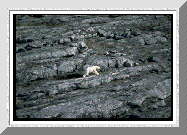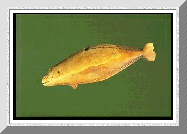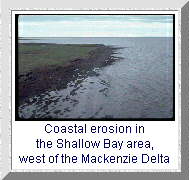


The Land
The wealth of the Inuvialuit homeland is best measured in its wildlife. It is the home of two great caribou herds; the Porcupine herd of the northern Yukon and the Bluenose herd to the east of the Mackenzie River. Muskoxen are found in the Horton River valley and were once abundant as far west as the Anderson River. Two species of bears are widespread; polar bears on the coast, and grizzlies inland. Kettle lakes and sloughs are abundant, and in summer the whole area abounds in waterfowl.




Offshore, in the waters of the Beaufort Sea, live huge bowhead whales and two species of seal; ringed and bearded. Belugas, a small, white, toothed whale about four metres in length, also summer in the Beaufort Sea in great numbers, congregating in pods of dozens or even hundreds of animals at major feeding grounds in the Mackenzie River estuary. And freshwater and anadromous fish are nearly everywhere abundant, including such important species as broad and crooked-back whitefish, inconnu, lake trout, cisco, and burbot.
Except for the Richardson Mountains, much of the Western Arctic is comparatively flat. Rivers tend to be slow and meandering, and pingos (a kind of giant frost boil) are a characteristic land form, often providing the only topographic relief as far as the eye can see. Like many northern areas which were not glaciated during the last Ice Age, the land is slowly sinking. Every year erosion pushes the coastline back - in some areas as much as ten metres in a single season - and islands which were once important settlement areas now flood with every storm tide.


By Arctic standards the land is well vegetated. A few spruce straggle northwards as far as tide water around the Mackenzie Delta and the upper Eskimo Lakes. Immense windrows of Mackenzie River driftwood clothe the beaches. The Tuktoyaktuk Peninsula and the Yukon north slope are, in summer, heavy with verdant growths of grass, willow, and brush, often too dense to be easily walked through, and as warm with mosquitoes. Only to the far northeast, around Cape Bathurst, does the traveler encounter the lingering summer snowdrifts and sparse vegetation characteristic of, for instance, the Central Arctic. Winters are cold, averaging between about -25C and -35C in January or February. Summers, however, tend to be a good month longer than in the Central Arctic, with a break-up in late June rather than July or August. In summer, most seas are entirely ice free from about mid-July, and do not begin to freeze again until late October. 

[Opening Page | The Land | The People | From Ancient Times | ...To 1902 | Survival |About the Researcher]